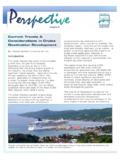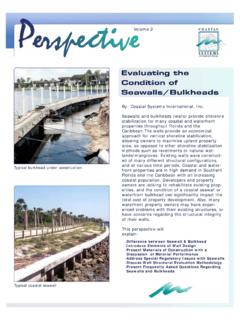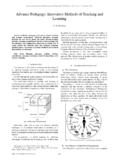Transcription of newsletter v5 final - Coastal Systems Int
1 By: Coastal Systems International, Datums impact Coastal engineering, dredging,navigation and law. Whether you are a captain of a ship ora waterfront property owner, the depth of the water is ofconcern. However, if you are driving through the EisenhowerTunnel in Colorado on Interstate 70 through the ContinentalDivide at elevation 11,112 feet above mean sea level, themean sea level reference is generally not a concern. A fewfeet difference at this elevation is not likely to cause anyproblems, but a few feet difference on the coast could meanthe grounding of a ship. The question is, what is mean sealevel, and if tidal datums vary along the coast, then does theelevation of Eisenhower Tunnel vary? Also, what is thedifference between MLW and MLLW, and how does NGVD orNAVD relate to these datums?
2 These are common questionsand sources of confusion along the coast, and thisperspective will provide an overview of tidal is important to understand a geodetic datum beforeaddressing tidal datums. These datums are easier tounderstand vertical references, since they are constantthroughout the United States. A geodetic datum is a fixedreference adopted as a standard geodetic datum for National Geodetic Vertical Datum (NGVD) was derivedfrom land surveys from a general adjustment of the firstorder level nets in the and Canada. Essentially,surveyors ran levels from coast-to-coast as mean sea levelwas held fixed at the sites of 26 tide gauges. The datum isdefined by the observed heights of mean sea level at the 26tide gauges and by the set of elevations of all bench marksresulting from the adjustment.
3 A total of 106,724 km ofleveling was completed. The National Ocean Service (NOS )lists the difference between tidal datums and NGVD forevery tidal datum along the coast. The relationship betweenthe geodetic datum and the local mean sea level is notconsistent at locations along the coasts. The elevation ofTidal DatumsFigure 1:Datum DilemmaVolume 5 Can I dock abigger boat here?Is the depthrelative toMLLW, MLW,NGVD, NAVD orMHW?Do you have atleast 1 foot ofclearance at MLWto protect theseagrass?4 feet deep!Eisenhower Tunnel is referenced to NGVD, and not meansea level. Although NGVD 29 closely resembles the meansea level of 1929, since measurements were madeconcurrently at 26 locations in has recently been superceded by the NorthAmerican Vertical Datum (NAVD) 88, which was derivedfrom a simultaneous, least squares, minimum constraintadjustment of Canadian/Mexican/United States levelingobservations.
4 The National Geodetic Survey (NGS) is agood source of information on the conversion from NGVDto NAVD. This transition process will take some time asmany construction plans, FEMA flood maps, topographicsurveys, dredging projects, etc. still reference TideThe rise and fall of the tides along the coast is a complexprocess, and the range of the tide influences theestablishment of a tidal datum. If the water levels alongthe coast did not change, there would be no need for tidaldatums. To help understand the need for establishmentof tidal datum, it is important to have a basicunderstanding of tidal hydraulics. By definition from theNational Oceanic and Atmospheric Administration (NOAA),the tide is the periodic rise and fall of the water resultingfrom gravitational interactions between the sun, moonand earth.
5 Most areas in the Atlantic Coastal UnitedStates are subject to semi-diurnal tides that have a period(or cycle) of approximately one-half of a tidal day, or tobe exact 12 hours, 25 minutes. The tide is actually awave; the wave period is the difference from the wavecrest to crest or trough to trough. For tides, the crest isessentially "high tide" and the trough is "low tide." Thereare two high and two low tides in a 24-hour day. Thereare two other types of tides, diurnal and mixed, which areobserved in some parts of the gulf coast of the UnitedStates. Figure 2 illustrates a semidiurnal 2:Basic Tide Figure (Courtesy NOS)Figure 3:Tide Figures (Courtesy NOS)Figure 3 and Table 1illustrate typical tidal rangesalong the Atlantic and Gulf Coasts of the United that the tide ranges vary greatly, with selectedmean tidal ranges in Table best source of information on tides and water levelobservations is the NOS Center for Operational andOceanographic Products and Services available online Miami, Seattle, New York:, New LOCATIONTIDE RANGE (ft)Table 1.
6 Tide RangesTidalDatumBased on the variability of the tides discussed in the aboveparagraphs, how does the NOS establish a tidal datumwhen the vertical plane of reference moves up and downrelative to a fixed geodetic datum such as NAVD 88? Atidal datum is simply the plane that defines theintersection between the ocean and the land, and it isreferenced to an average fixed height of the water levelduring the tidal cycle. The datum is determined fromwater level measurements obtained along the coastincluding estuaries and rivers influenced by the tide. TheNOS, which is a branch of the NOAA, is responsible forestablishing tidal datums and monitoring water levels inthe United States. It is important to remember that tidaldatum are local datums, and they vary from location tolocation along the NOS has conducted water level observations toestablish these tidal datums.
7 All water level observationsare referenced to a specific 19-year metonic cycle, or theNational Tidal Datum Epoch. The epoch is used for tidaldatum determinations, and the 19-year metonic cycle isused to obtain the arithmetic mean of tidal heightobservations so that all tidal datum determinationsthroughout the United States will have a commonreference. The current National Tidal Datum Epoch is1983-2001, which recently superceded the previous1960-1978 water level observations are averaged to providethe following datum: Mean Low Water (MLW): The arithmetic mean of thelow water heights observed over a specific 19-yearMetonic cycle. Mean Lower Low Water (MLLW):The arithmetic meanof lower low water heights of a mixed or semi-diurnal tide observed over a specific 19-year Metoniccycle.
8 Only the lowest low water of each pair of lowwaters of a tidal day is included in the mean. MLLWis the nauticalchart datum for navigation in theUnited , the definitions for Mean High Water (MHW) andMean Higher High Water (MHHW) are based on averagesfor the respective high water heights. A typical tide stationsheet as published by the NOS is listed in Table 2: Tidaldatum at Virginia Key, Biscayne Bay, Florida. (Station8723214).Note the difference between MLW and MLLW in Table 2isonly feet in the Miami, Florida area. This differencein Seattle, Washington is feet!The NOS relies on a network of control tide stations forthese 19-year metonic cycle observations. These primarystations are supplemented by secondary and tertiarystations to provide adequate tidal datum coverage alongthe coasts.
9 Secondary stations operate for at least oneyear, but less than 19 years. Tertiary stations operate lessthan one year but more than one month. The NOSmathematically adjusts the measurements at a tertiary orsecondary station to establish tidal datum for a particulararea since it is not practical to observe tides for 19 yearsat each location. In the State of Florida, there are over300 separate tidal datums. The Virginia Key tidal datumin Table 2is based on 8 years of observations, andtherefore it is a secondary tide station referenced to acontrol station in Key Surveys & DatumsConventional topographic land surveys and maps typicallyreference a geodetic datum. Coastal shoreline areas andwaterfront properties are areas where land andhydrographic surveys often overlap.
10 The use of properdatums can be confusing. Some regulatory agenciesrequire surveys referenced to the geodetic datum,however, tidal datum references are required tounderstand navigation and the depth of water at apotential marina site, for example. Hydrographic surveysare conducted to map the sub-surface are conducted for applications such as shippingchannels and for dredging. For all surveys (land andhydrographic) conducted in tidal areas, a diagram ofdatum plane is a helpful tool that graphically illustratesthe differences between the datum, and ALWAYS references a geodetic datum. The relationship betweenNAVD 88 and the tidal datum (usually MLLW) should beshown on the survey map as illustrated in Figure OF SERIES:8 YEARSTIME PERIOD:01/1994 - 12/2001 TIDAL EPOCH:1983 - 2001 CONTROL TIDE STATION:8724580 KEY WESTHIGHEST OBSERVED WATER LEVEL (11/15/1994)= ( )MEAN HIGHER HIGH WATER (MHHW)= ( )MEAN HIGH WATER (MHW)= ( )NORTH AMERICAN VERTICAL DATUM-1988 (NAVD)= ( )MEAN TIDE LEVEL (MTL)= ( )MEAN LOW WATER (MLW)= ( )MEAN LOWER LOW WATER (MLLW)= ( )LOWEST OBSERVED WATER LEVEL (03/29/1994)= ( )ELEVATIONS OF TIDAL DATUM REFERRED TO MEANLOWER LOW WATER (MLLW), IN METERST able 2:Typical Tide Station SheetDisclaimer: The material presented in this perspective isfor general information only.




